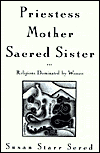
This is the book we should all be reading, for in it Susan Starr Sered, a senior lecturer in sociology and anthropology at Bar-Ilan University in Israel, shows that the writers of the ovular books in feminist spirituality did not invent women's religion. Indeed, Sered takes as her primary examples a dozen religions from around the world: the matrilineal, nameless religion of Ryukyu Islands (Okinawa), the Burnese nut religions, the spirit cults of northern Thailand, and Korean household shamanism; Christian Science, Spiritualism, the Shakers and feminist spirituality in the U.S.; and African and Afro-Brazilian religions, including the Sande Secret Society of West Africa, the zar cult of Islamic nations in North Africa and the Middle East, and Black Carib religions. We are not alone.
What is a women's religion? At the risk of enormously oversimplifying Sered's theses, it is primarily matrifocal. That is, it focuses on motherhood and on the sacralization of domestic life. Women's religions, which nearly always exist side-by-side with the dominant patriarchal religion, show how women construct reality, and because women's religions tend to focus on this world instead of the other (far-off, after-death) world, the sacred is seen to be in the profane, not apart from it. Women's religions help women deal with the birth and death of their children and explain misfortune and suffering, both individually and on behalf of women at large. And women's religions are polydeistic. As Sered writes, "It seems to me that monotheism may be too final, too absolute, to answer the needs of religions whose raison d'etre is the alleviation of suffering in this world. Monotheism leaves little room for negotiation," whereas polydeism "offers endless possibilities for explaining...and (hopefully) healing suffering and illness." (p. 171)
Page after page of this scholarly and fascinating book gives us insights to ponder. Female founders of religions, like the Shakers' Ann Lee, are often called Mother, and the founder of a new Japanese religion, Mrs. Kitamura, in fact found the Absolute God of the Universe dwelling in her abdomen. At first she thought it was an evil spirit until it revealed its true nature to her, and now she and her followers call it "God-in-her-abdomen" (p. 76) A "pivotal component" of several of the women's religions (Spiritualism, Shakers, the nat and zar cults) is trance and possession by ancestral or other spirits, which leads Sared to comment, "It is legitimate to argue that women have some sort of affinity for spirit possession (or that spirits have some sort of affinity for women)..."(p. 182) The traits of women's religious leaders include empathy, kindness, intelligence, age, eloquence, acting ability, musical ability, poise, courage, authority, and competitiveness (table, p. 226).
Finally, Sered writes the following on ritual: "[It] is the outward face of religion. Through ritual, people give expression to their beliefs, their myths, and their hopes and fears. Successful and persuasive ritual strengthens people's conviction that their religious institutions are powerful and true. Ritual serves to consolidate disparate individuals into a group, and ritual serves to link that group to other, supernatural realms. Ritual is a tool for eliciting altered states of consciousness in participants. And rituals are among the most widespread means used by human beings who wish to manipulate their environments, ward off misfortune, and ensure well-being for themselves and their loved ones." (p. 120)
~review by Barbara Ardinger, Ph. D.
Author: Susan Starr Sered
Oxford University Press 1994
$27.50
